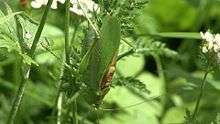Tettigonia cantans
| Tettigonia cantans | |
|---|---|
 | |
| Tettigonia cantans, male | |
| Scientific classification | |
| Kingdom: | Animalia |
| Phylum: | Arthropoda |
| Subphylum: | Hexapoda |
| Class: | Insecta |
| Order: | Orthoptera |
| Family: | Tettigoniidae |
| Genus: | Tettigonia |
| Species: | T. cantans |
| Binomial name | |
| Tettigonia cantans (Fuessly, 1775) | |
| Synonyms | |
| |
Tettigonia cantans is a species of katydids belonging to the family Tettigoniidae subfamily Tettigoniinae.
This katydid is present in most of Europe, in eastern Palearctic ecozone, in Near East and in North Africa.

The adult males grow up to 20–30 millimetres (0.79–1.18 in) long, while females reach 29–35 millimetres (1.1–1.4 in). They can be encountered from mid July through October mainly in mountain habitats, in moist grasslands, shrubs and bushes, forest clearings, cultivated areas, sunny roadsides, etc. They mainly feed on other insects, but also on vegetable foods.
The basic coloration of the body is usually green, with a brown stripe on the back. These grasshoppers hardly fly, their wings are shorter and wider than in the other Tettigonia species, only slightly covering the end of the abdomen. The ovipositor of the female extends beyond the tip of the wings.
Adults are active from noon till night and males are detectable by their characteristic and pleasant singing (hence the Latin name cantans). The females lay eggs in moist soil.
 |
Sound of Tettigonia cantans
Field recording in the Netherlands 35s |
| Problems playing this file? See media help. | |

Gallery
 Tettigonia cantans, female
Tettigonia cantans, female Tettigonia cantans, male
Tettigonia cantans, male Tettigonia cantans, male
Tettigonia cantans, male- Tettigonia cantans, male nymph